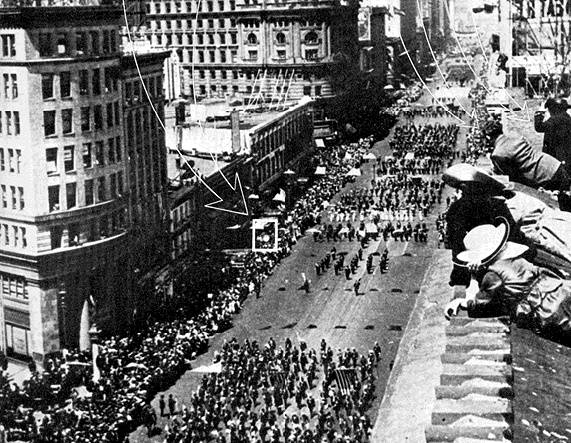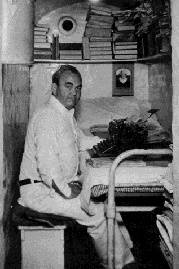TOM MOONEY: Difference between revisions
(added photo credits) |
No edit summary |
||
| Line 29: | Line 29: | ||
Behind the scenes was one Martin Swanson, a detective with a long involvement in strikes, and various labor confrontations in San Francisco, mostly working for PG&E, the Pacific Telephone and Telegraph Co. (later PacBell), and other utilities and railroads. Swanson had spent a couple of months trying to frame Mooney for a bombing of PG&E power lines just south of San Francisco on San Bruno mountain, offering bribes of $5,000 to several of Mooney's allies. He also maintained constant surveillance and harassment of Mooney, Billings, and the anarchists [[Goldman and Berkman in SF|Alexander Berkman and Emma Goldman]], who were living at 569 Dolores in the Mission District. | Behind the scenes was one Martin Swanson, a detective with a long involvement in strikes, and various labor confrontations in San Francisco, mostly working for PG&E, the Pacific Telephone and Telegraph Co. (later PacBell), and other utilities and railroads. Swanson had spent a couple of months trying to frame Mooney for a bombing of PG&E power lines just south of San Francisco on San Bruno mountain, offering bribes of $5,000 to several of Mooney's allies. He also maintained constant surveillance and harassment of Mooney, Billings, and the anarchists [[Goldman and Berkman in SF|Alexander Berkman and Emma Goldman]], who were living at 569 Dolores in the Mission District. | ||
[[Image:labor1$mooney-in-san-quentin.jpg|left | <div class="body-image"> | ||
<div class="body-image-image"> | |||
[[Image:labor1$mooney-in-san-quentin.jpg|left]] | |||
</div> | |||
<div class="body-image-caption"> | |||
'''Tom Mooney in his cell in San Quentin (c. 1932)''' | |||
</div> | |||
<div class="body-image-credit"> | |||
''Image: Bancroft Library'' | |||
</div> | |||
</div> | |||
<p>After the Preparedness Day bombing, Swanson was appointed as investigator for the (clearly corrupt) District Attorney that same evening. Over the next two years it was gradually revealed that Martin Swanson was the man primarily responsible for finding and coaching false witnesses against Mooney and Billings. Tom Mooney was tried first, and based on the false evidence, convicted of first degree murder and given the death sentence. Some time later Warren Billings was tried, and though some of the testimony had already been discredited, he too was convicted of first degree murder but given a life sentence. The three other alleged co-conspirators were tried later and all acquitted as the fraudulent case against them had collapsed by then.</p> | |||
Mooney had his death sentence commuted to life in prison by California's governor under pressure from President Woodrow Wilson in 1917. It took another 22 and a half years before Tom Mooney was granted an unconditional pardon by newly-elected liberal Democratic governor Culbert Olson in January, 1939. Warren Billings would receive his release from prison in 1942. | Mooney had his death sentence commuted to life in prison by California's governor under pressure from President Woodrow Wilson in 1917. It took another 22 and a half years before Tom Mooney was granted an unconditional pardon by newly-elected liberal Democratic governor Culbert Olson in January, 1939. Warren Billings would receive his release from prison in 1942. | ||
Revision as of 15:51, 28 April 2016
Historical Essay
by Chris Carlsson
Market and Steuart Streets moments before the Preparedness Day Bombing, July 22, 1916. This picture was suppressed by the prosecution for 20 years. The arrow points to what some think may have been the actual bomber.
Photo: courtesy Bancroft Library
July 22, 1916 "Preparedness Day:" A turning point in labor history for San Francisco and perhaps for the entire United States.
A large parade up San Francisco's Market Street had been organized by the Chamber of Commerce and the conservative business establishment to drum up patriotism and support for U.S. entry into the European war (WWI). In addition to the war in Europe, U.S. troops were already gathering at Nogales to invade Mexico in pursuit of Pancho Villa, Irish exiles had passed only three months since the Easter Rebellion in Ireland, a bloody strike on San Francisco's waterfront had killed a man and left dozens injured only a month earlier. At 2:06 pm, as marchers were entering Market Street from Steuart (between the old SP building at 1 Market Plaza, and the new Federal Reserve Building), a bomb exploded, killing ten and critically injuring 40 more.
A militant San Francisco labor leader, Tom Mooney, his wife Rena, a radical worker named Warren K. Billings, and two others were soon charged with the crime. Then District Attorney Charles Fickert had been elected in 1909 with a secret fund of $100,000 put up by United Railroads, a company formed in 1905 when Patrick Calhoun bought up most of the city's streetcar lines and merged them into one company. One of DA Fickert's first acts was the dismissal of corruption charges pending against Calhoun, his chief counsel and his chief assistant, thereby ending the famous graft trials which had brought down political boss Abe Ruef and previous Mayor Schmitz.
Tom Mooney had real evidence of his innocence, but was denied a new trial or pardon for 22 years. At 2:01 p.m. on July 22, 1916, a photo by Wade Hamilton places Tom and Rena Mooney on the Eilers Buildng at 975 Market, at the time they were allegedly placing the bomb a mile east at Steuart and Market. This photograph was in the possession of the prosecutors but was never presented at trial.
Photo: courtesy Bancroft Library
Mooney had been a major actor in numerous strikes and organizing campaigns. By the end of 1915 he'd become a thorn in the side of the San Francisco Labor Council as much as the Chamber of Commerce with his radical calls for industrial unionism; Pacific Gas & Electric and its then subsidiaries (San Joaquin Light & Power Co., Western Electric Co., Sierra & SF Power Co.) considered him a dangerous foe after a big strike from May 1913 through January 1914.
In late 1915, Mooney had targeted the anti-union United Railroads for organizing. In 1916, California had two major cities, San Francisco and Los Angeles, the former known as the most unionized city in America, the latter as a bastion of conservatism and the most open shop (i.e. non-union) city in the country. San Francisco's Chamber of Commerce keenly felt the difference, as new investment was mostly heading south to Los Angeles and the land of cheap, abundant labor.
Between June 9, 1916 and July 17, the San Francisco Chamber of Commerce claimed that 38 "non-union workers" [scabs] were sent to the hospital because of attacks by striking longshoremen. Two strikers were dead. In this violent atmosphere the Chamber issued its first public endorsement of the open shop on June 22, 1916. On July 10, a meeting of over 2,000 merchants packed the floor of the Merchant's Exchange and endorsed the creation of a standing "Law and Order Committee" of the San Francisco Chamber of Commerce to "rid San Francisco of anarchistic elements." By year-end the Law and Order Committee had a fund at its disposal of $1 million.
Behind the scenes was one Martin Swanson, a detective with a long involvement in strikes, and various labor confrontations in San Francisco, mostly working for PG&E, the Pacific Telephone and Telegraph Co. (later PacBell), and other utilities and railroads. Swanson had spent a couple of months trying to frame Mooney for a bombing of PG&E power lines just south of San Francisco on San Bruno mountain, offering bribes of $5,000 to several of Mooney's allies. He also maintained constant surveillance and harassment of Mooney, Billings, and the anarchists Alexander Berkman and Emma Goldman, who were living at 569 Dolores in the Mission District.
After the Preparedness Day bombing, Swanson was appointed as investigator for the (clearly corrupt) District Attorney that same evening. Over the next two years it was gradually revealed that Martin Swanson was the man primarily responsible for finding and coaching false witnesses against Mooney and Billings. Tom Mooney was tried first, and based on the false evidence, convicted of first degree murder and given the death sentence. Some time later Warren Billings was tried, and though some of the testimony had already been discredited, he too was convicted of first degree murder but given a life sentence. The three other alleged co-conspirators were tried later and all acquitted as the fraudulent case against them had collapsed by then.
Mooney had his death sentence commuted to life in prison by California's governor under pressure from President Woodrow Wilson in 1917. It took another 22 and a half years before Tom Mooney was granted an unconditional pardon by newly-elected liberal Democratic governor Culbert Olson in January, 1939. Warren Billings would receive his release from prison in 1942.
<iframe src="https://archive.org/embed/ssfMOONEDT1" width="640" height="480" frameborder="0" webkitallowfullscreen="true" mozallowfullscreen="true" allowfullscreen></iframe>
Mooney appeals for his release in 1933 (video)
____
6 Weeks Earlier
On the morning of June 10, 1916 these notices were posted inside United Railroad carbarns in San Francisco:
June 10th, 1916— NOTICE TO EMPLOYEES
This is to inform you that one Thomas J. Mooney, a moulder by trade, but at present unemployed, who was arrested and confined in jail as a dynamiter for his activities during the Pacific Gas and Electric Company's strike in 1913, is at present endeavoring to enroll some of our employees in the Carmen's Union. It is needless to advise you that the company is thoroughly familiar with his every move and takes this occasion to notify you that any man found to be affiliated with Mooney or any union, will be promptly discharged.
—United Railroads of San Francisco
That night, June 10th, Tom Mooney rode to a union meeting at Woodman's Hall on 17th Street. In spite of more than 30 armed men surrounding the entrance, Mooney and a couple of hundred men came in to the meeting (the number of actual carmen may have been small, as there were many spies present as well). Although a wildcat strike was discussed at length, Mooney was so discouraged by the poor turnout that he didn't even bring a strike to a vote. At about 10 p.m., Mooney called a brief recess and went to a small nearby room. One of the URR spies, thinking Mooney had left the building, was observed going to tell some of the railroad's goons that Mooney was gone. The meeting resumed shortly and didn't finish until about 1 a.m.
It was fairly obvious to Mooney and his friends that an attempt was being made to kill the strike before it started by railroading its organizer on a phony dynamiting charge... If it was a frame-up (only a supposition), two errors were probably responsible for it going awry. One was that Martin Swanson [chief of security for PG&E, employed by URR, PacTel, and others to counter organized labor] who was at the scene minutes after the explosion, where he found a suitcase of unexploded dynamite and a clock-timing device - thought Mooney had left the meeting shortly after ten. Several witnesses saw a man dressed like Mooney carrying two suitcases near the towers about 11 p.m. (Swanson had their affidavits, which he would turn over to Fickert after the Preparedness Day bombing). At 11, however, Mooney was presiding over the organizational meeting, as some 200 men could verify, having been out of the room only a few minutes, far less time than would have been required for him to go to San Bruno, much less there and back.
--excerpted from Curt Gentry, Frame-Up (New York: W.W. Norton 1967)
READ MORE:
Frame-up by Curt Gentry, © 1967, WW Norton & Co., New York.
Life of an Anarchist: The Alexander Berkman Reader, ed. Gene Fellner, Four Walls Eight Windows, New York: 1992.
<iframe src="https://archive.org/embed/ssfMOON1916" width="640" height="480" frameborder="0" webkitallowfullscreen="true" mozallowfullscreen="true" allowfullscreen></iframe>
Chamber of Commerce cartoon warning population



